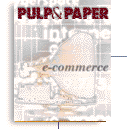
The New Economy
We are in an era of profound change. Paper companies are being gobbled up in the interests of scale and reach. Other paper companies are shedding assets and businesses in the interest of market/segment focus. Still others are attempting to unlock the value of underlying assets through letter stock and timberland spin-offs. Global alliances and joint ventures are emerging overnight. All these structural changes probably make sense. However, they represent the tip of the iceberg of what is yet to come.
We are, in fact, at the cusp of a New Economy. The New Economy is being driven by globalization, over-capacity and, importantly, by ever-increasing improvements in information technology, particularly the Internet. As a result, new I.T.-enabled business models are emerging where the customers manage the relationship, where the business is designed from the customer backwards, and where network intermediaries are emerging who want to broker the customer-supplier relationship.
Frankly, there’s an all-out war for the customer and for the channel. And, this war will put even more pressure on prices. In fact, the Internet will have an incredibly deflationary impact throughout our economy. Its impact will be very disruptive, even to asset-intensive paper companies.
Vertical Integration. Vertical integration has been at the core of many paper company strategies for years. This strategy provided assurances that paper companies could leverage the huge capital outlays necessary to build and operate world-class mills. We wanted to be certain that we never ran out of fiber, that we kept the mills running at or above their originally designed capacity, and that we always had a place to push our product into the channel. It’s clear that this mill-centric model has not served paper companies well over the past decade as evidenced by consistently poor returns to shareholders.
Paper companies are increasingly recognizing that the era of production push is over. They’re realizing that the last ton produced tends to be the most expensive and tends to be sold at the lowest cost. Many have shifted capital spending away from increasing output toward programs that reduce waste and variable cash costs. The most foresightful paper companies are implementing a demand-pull business model and are beginning to run much closer to the natural demand of the marketplace.
Virtual Integration. We envision a future where paper companies increasingly specialize and excel in the parts of the value chain where they have developed a true core competence. Some may focus on paper manufacturing, others on converting, and still others on distribution. Some may focus on forestry and wood products. Dot-com companies will try to step in and broker the customer-supplier relationship. Some of these companies will have fulfillment capabilities, others will just provide an electronic marketplace. Efficient markets for selling of wood, pulp, and paper products will emerge based on more perfect information available on the Web. The historical advantages of complete vertical integration will fall by the wayside. In the broadest sense, everyone will become a network intermediary in this radically disaggregated value chain.
Customer-centric Models. While physical assets will always play an important role, the future belongs to those who are able to envision new value propositions that leverage customer relationships. Implementing new business models starts with a thoughtful and far-reaching view on new ways to interact with the customer. Nothing new here, except that for the first time, you’ll be considering the impact of a new Web-based world of commerce. Old questions will reemerge and require thoughtful analyses and discussion: What businesses are we in?, what customers will we serve?, how do we compete?, how do we win?
Once you’ve decided where the business will be focused, building Web-enabled capabilities will be important. The emphasis should be on making it incredibly easy for the customer to do business with you. All of this is about leveraging the customer relationship while you still can and creating strategic hooks.
What To Do. How should paper companies respond? Get out in front. There are significant advantages for those who change fast and build the new business capabilities required to compete in the New Economy before someone else does.
Every company, large and small, needs a thoughtful e-business strategy. The e-business strategy should be anchored in the realities of the New Economy and focus on emerging new business models. The emphasis should be on searching for brand new business opportunities, not how to preserve the status quo. Seek opportunities, don’t try to solve problems.
The brave will conclude that it’s time to redefine the very essence of the business, calling into question age-old paradigms about how to make money in this industry. They’ll recognize that the e-business strategy is a major chapter in the overall business strategy, and treat it very seriously.

|





